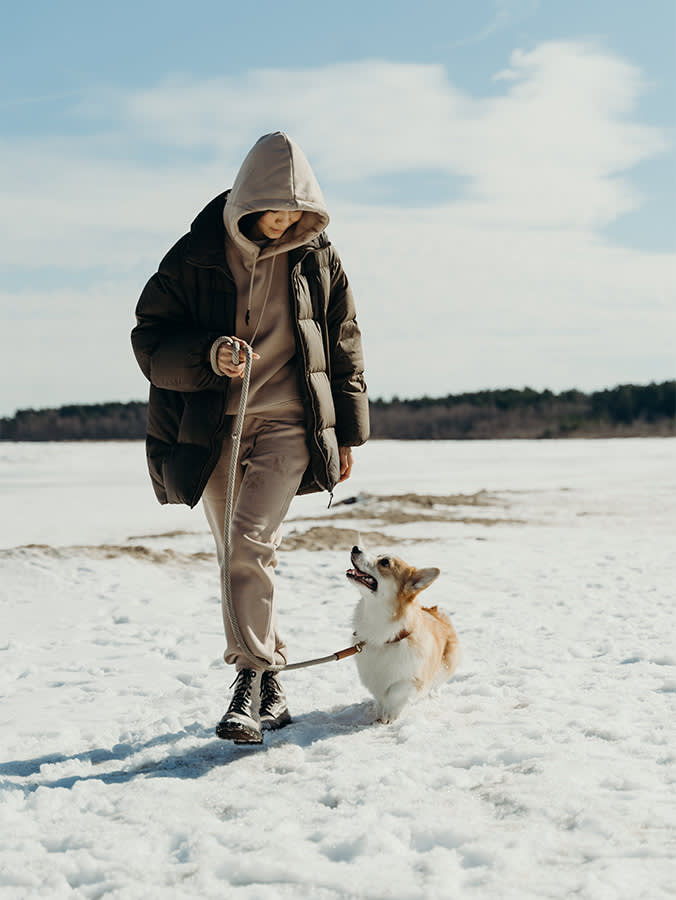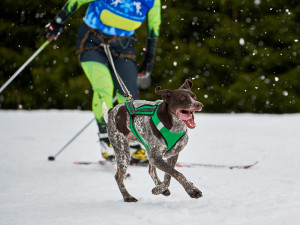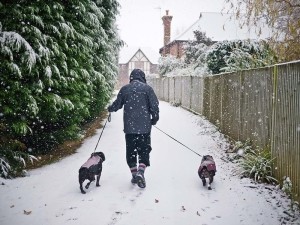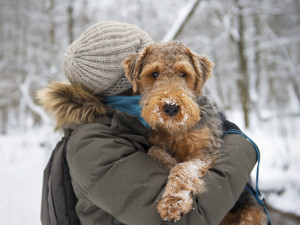Does Your Pup Have Snow-Hound Potential?
Making tracks is another way to enjoy a snowy day with your pup.

share article

Your pet wants you to read our newsletter. (Then give them a treat.)
Snowshoeing with dogs? You bet. There are few finer ways to spend a winter day with your pup than a trek on snowshoes along your favorite trail or a heart-thumping workout through high-octane terrain. Many dogs love to go romping around in the snow, so what better way to join them? With a little common sense and cold-weather know-howopens in a new tab, you can keep your dogs safe and healthy while exploring an untrammeled wilderness area, groomed trails at a touring center, or even a snow-covered public golf course.
What is Snowshoeing?
Snowshoeing is an ancient form of over-the-snow transportation — Native Americans are said to have used snowshoes more than 3,000 years ago — is one of the fastest-growing winter activities for those who live in or visit the country’s snow belt. And for good reason — as a sport, it doesn’t get much simpler. While snowshoeing might conjure up images of plodding along on tennis-racket-like contraptions, 21st-century equipment combines state-of-the-art design with high-tech materials such as lightweight aluminum, composite plastic, and even titanium. If you can walk, goes the adage, you can snowshoe.
Before going snowshoeing with your dog:
Before heading out on the fresh powder with your pup, make sure your dog is healthy enough for the trek, pick up the right gear, and map out your route. Here are a few tips for snowshoeing with your dog.
1. Does your pup have snow-hound potential?
“You need to consider whether your dog is healthy to start with,” says Dr. Peter Humphrey of Torrington Animal Hospital in Torrington, Conn. “Heart-related or respiratory problems can have an impact on a dog’s stamina.” Most fit and trim dogs will do fine, he says, but remember, they don’t walk on the snow like you do. “Walking through deep snow is physically demanding,” notes Humphrey, who recommends a shorter-than-usual first outing, since “you may end up with an exhausted pet that you have to carry back.”
And while your canine may be furry, exposure to the elements can lead to problems like frostbite or hypothermia. Puppies and elderly dogs are especially susceptible; watch for shivering, slowed breathing or dilated pupils, signs of a dangerous drop in body temperature.
2. Make sure to dress your pup for the elements.
Unless you have a northern breedopens in a new tab, say, an Akita, Husky, or Malamute, who are “dressed” for the cold, your dog might also benefit from the added insulation of a doggy coat. Pack plenty of snacks and water, and examine your dog’s pawsopens in a new tab frequently for the ice and snow that can clump between pads. Companies like Ruff Wearopens in a new tab offer first-aid kits for dogs, protective booties, collapsible food and water bowls, and cold-weather apparel you may want to consider adding to your gear.
3. Be sure to check your trail before heading out.
Check that the trail system you’re planning to visit is dog-friendly, and, if so, find out what the rules are. Some charge a fee; others allow dogs only in certain areas or require them to be leashed. Other trail users will judge dogs and pet parents by your actions, so practice good etiquette, such as picking up after your pup, keeping them under control, and — this is critical — staying out of the way. Nothing will rile a cross-country skier quite like grooved tracks obliterated by snowshoes and dog paws.
4. Your pup should have good recall and manners.
If dogs are allowed off-leash, they should respond perfectly to voice commands. “If your dog can [be depended on to respond to your verbal commands], regardless of distractionsopens in a new tab, you may not have to have him on a leash,” explains Llona Ney Clausen, manager of the Nordic & Snowshoe Center at Tamarack Resort in Donnelly, Idaho. “The biggest problem will be, of course, when a dog meets another dog.”
Andi Marie Cantele
Andi Marie Cantele is the author of Backroad Bicycling in Western Massachusetts and 52 Weekends in Connecticut (both from Countryman Press), among others; she lives in Connecticut.
Related articles
![Person with two small dogs that won't poop in snow]() opens in a new tab
opens in a new tabHow to Teach Your Dog to Poop in the Snow
Snow days are fun—until your pup needs to do their thing outside.
![Pit Bull dog wearing a coat on leash with person in the snow]() opens in a new tab
opens in a new tabDoes Your Dog Need a Winter Coat?
Chilly pup refusing to layer? Here’s how to train them to love their winter wardrobe.
![shaggy brown dog plays in the snow outside]() opens in a new tab
opens in a new tab8 Activities That Keep You and Your Dog Out of the Snow
Tips to avoid boredom when cooped up during all this winter weather.
![A woman holding a dog outside in the snow]() opens in a new tab
opens in a new tab9 Ways to Keep Your Dog Safe in the Snow
Sometimes, your pup has to be exposed to the elements—and you have to keep them warm when they are. Here’s how.




